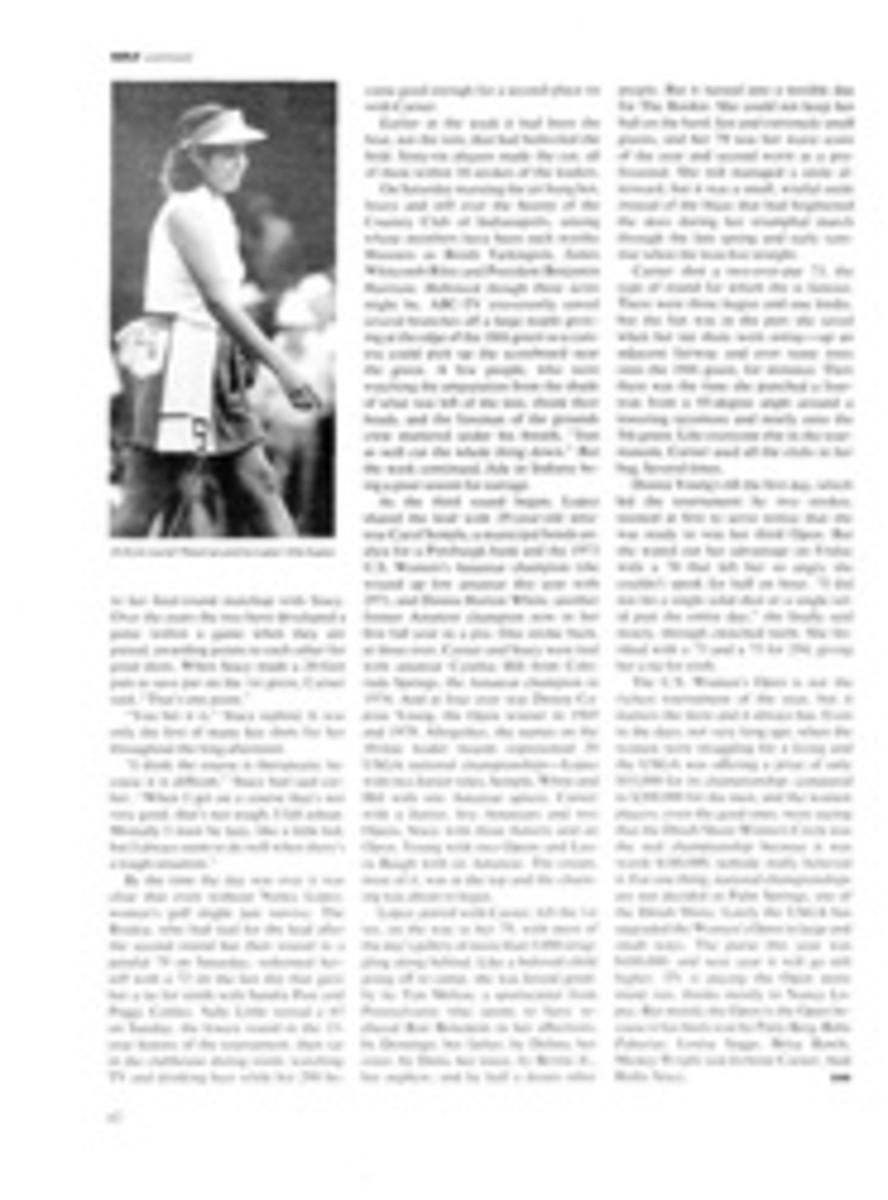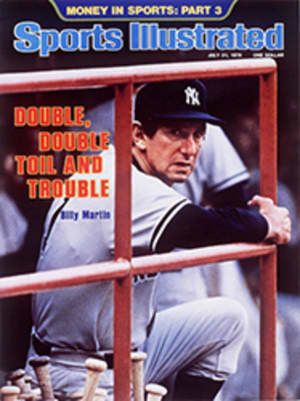
A welter of welters
Normally a placid 20-year-old, when he gets into the ring Pipino Cuevas becomes what his fellow Mexicans call a tipo asesino—an assassin type. At the start of the first round, he surges out of his corner throwing punches as if his opponent had just insulted his mother. For this reason, and others, Pipino Cuevas is the welterweight boxing champion of the world.
Carlos Palomino, a 28-year-old college graduate, usually starts his fights slowly, watching for openings. He gets stronger and more assertive as the match wears on. An opponent must either take Palomino out early or suffer a battering. He is more a surgeon than an assassin. Palomino also is the welterweight boxing champion of the world.
The World Boxing Association recognizes Cuevas, the World Boxing Council recognizes Palomino, and everyone recognizes that a match between the two would not only settle the title but also be a very big draw. "The thing that's holding it up is money," says Palomino at his Huntington Beach, Calif. home. "The networks or the promoters are unwilling to pay what each one of us is asking, say, $500,000 each. In an age when they're putting up millions of dollars for the heavyweights, I can't see why they can't pay a fraction of that to title-holders in another division. And this would be a more interesting fight than most heavyweight matches that can be made right now."
Cuevas won his version of the title July 17, 1976, in Mexicali, Mexico, by knocking out Angel Espada in the second round. The toughest of his six defenses was a return engagement against Espada in San Juan, Puerto Rico late last year; Cuevas won that one on an 11th-round knockout, or about nine rounds late for him.
Cuevas now fights mostly in California, where his matches are promoted by ex-Los Angeles Rams Placekicker Danny Villanueva, now a sportscaster on KMEX, a Spanish-language TV station in Los Angeles. "The rumor is that Cuevas fights three rounds in the dressing room before he even goes out to fight," says Villanueva. "I'm not kidding you."
"I've seen a few of his fights," Palomino says. "Only one in person, the others on television. Cuevas is a very strong guy. He depends a lot on his left hand. He's a hooker from the word go. He starts a fight very, very fast; just comes out smoking. But one thing, he's very easy to hit. He can be hit just about at will. I'm very confident I can beat him for that reason. Cuevas hasn't fought anybody with a punching ability in my class."
"Cuevas is fairly easy to hit," agrees Palomino's manager, Jackie McCoy. "And he does sure enough come out swinging, all right. The only thing is, Cuevas is very dangerous those early rounds. He seems to tire as the rounds go by, but he's liable to kill about three guys before he runs out of gas. That's the bad part."
Cuevas, who is listed as "Jose Pipino Cuevas" in The Ring record book but as Pipino Cuevas Gonzalez on his birth certificate, is part Italian on his mother's side of the family, hence the Italian diminutive Pipino rather than the Spanish Pepe. The son of a butcher, he grew up in the Colonia Panamericana section of Mexico City with four brothers and six sisters.
According to Villanueva, Cuevas got into a lot of trouble as a boy, so his father took him to a gym at age 13. At 14 he turned professional and suffered four early losses—two in 1972, two in 1973—but only one since. At 18 he was a champion, decking Espada with, yes, a left hook.
Cuevas' training base for the last three years has been a second-floor public gymnasium above the Arce Public Baths in Mexico City. There the young fighter is put through his daily hour-and-a-quarter workouts by Manager Lupè Sanchez. Cuevas loves to train, says Villanueva, does everything Sanchez tells him to do and stays away from serious social entanglements. It has paid off: he owns five automobiles—an LTD, a Valiant, a Gremlin, two Dodges—and a four-ton truck. The truck is for hauling meat to the three butcher shops he has bought for his father. Cuevas is also a qualified butcher—in the literal sense.
Palomino was born in Mexico, too, but moved to the U.S. with his parents when he was 10 and is an American citizen. He grew up for the most part in Westminster, near Long Beach, but the two years he spent with an aunt in the San Joaquin Valley farm town of Corcoran were invaluable, because his aunt never let him skip school and made him study two or three hours a day. As a result a tough Tijuana street brawler became a fairly good student, eventually attending junior college and then getting a recreation-administration degree from Cal State-Long Beach.
Palomino became a welder when he graduated from high school and in February of 1970 started working out in a gym, where he caught the eye of a fight manager named Noe Cruz. But before Palomino could get his amateur license, he was drafted into the Army.
"I went to Fort Hood, Texas and I signed up for the post boxing tournament, and that was the beginning," says Palomino. "I won the Fort Hood tournament as a welterweight. Then I got sent to a bigger tournament, the Fourth Army, and I won that. And from there they sent me to the All-Army Tournament, which is a very, very big one. There's 500, 600 guys there trying to make the Army boxing team." Palomino pared himself down to 139 pounds, won the junior welterweight division and competed for the Army team at that weight. The Army coaches had him sleeping in plastic workout suits and eating less than a barracks mouse.
"They made a 139-pounder out of him," says McCoy, "but I don't know how they did it. I have a hard time keeping him at 147."
McCoy (nè Warren Spaw), a veteran longshoreman and fight manager, was brought in by Cruz when Palomino was discharged in 1972. He and Cruz are co-managers, but McCoy does the negotiating with promoters.
McCoy wasn't too impressed with Palomino at first, pegging him as just another straight-up AAU fighter. Still, Palomino was undefeated until he injured a shoulder in his eighth fight. He was told that he would probably never be strong enough to fight again.
"Then I met this Chinese acupuncturist," Palomino says. "He gave me 10 treatments, and in May of '74 I had my first fight coming back. I haven't had a problem since."
Palomino was indeed a much improved fighter after the needling. "I don't know what happened," says McCoy. "Before he was hurt he looked like a typical AAU fighter. When he came back, he started punching a lot harder and looked a lot better."
"The biggest change was that I started doing more things in the gym," Palomino says. "I began experimenting, looking for new ways to block and throw punches. Some guys are afraid to experiment because they know they'll get banged the first couple of times. But it made me a better fighter."
Did it ever. Palomino's record was 19-1-3 when he got his big chance—for a measly $10,000 and expenses, according to McCoy. He would meet John Stracey of England for the WBC welterweight title. Palomino had fought to a draw with Hedgemon Lewis seven months before, and Stracey would be only the second big-name boxer he had ever met. Stracey's handlers expected an easy victory.
On June 22, 1976, in London's Wembley pool, Palomino beat Stracey on a TKO in the 12th round after putting him down for two eight-counts with body punches. Since then the champ has defended the title seven times and improved his record to 27-1-3. McCoy says that for the last defense, against Armando Mu‚Äö√†√∂¬¨¬±iz—also, curiously, a college graduate—Palomino got $132,000, not to mention a broken left hand.
Cuevas and Palomino have fought only two common opponents. Both lost early decisions to an otherwise undistinguished fighter named Andy Price before becoming champions, Palomino in 1974, Cuevas in 1976. And both defeated Jose Palacios, Cuevas on a TKO in the 10th, Palomino on a knockout in the 13th round.
Villanueva, among others, both fans and promoters, savors the prospect of their meeting in Los Angeles. "What you've got here is a very interesting matchup," he says. "You've got the slow starter, the calculating, mature fighter who started boxing very late in life—Palomino. A veteran of the service who waits his turn. And then you've got this magnetic 20-year-old who won a championship as a teen-ager.
"Cuevas knocks 'em out in the first round if he can. The other one doesn't get started until the fifth, then he gets steamed, steamed. By the 10th, the 15th, he's unbeatable. Pipino isn't the boxer that Palomino is. Palomino doesn't have the punch that Pipino has.
"Pipino is in a class by himself as a draw. At the gate he's just unbelievable. Let me give you an example. Carlos Zarate, great little fighter, unbeaten, defended his bantamweight title at the Forum and drew 15,000. Now, that's for a title fight. The next day 6,500 people watched Pipino work out at the Olympic Auditorium! Whatever it is that Ruben Olivares had, and whatever it is that Pajarito Moreno had, whatever it is that those chosen few have, Pipino Cuevas has. In Mexico they call it angel. Angel. He has an angel. Whatever it is, people go crazy."
Promoter Bob Arum of Top Rank in New York says the match will be made soon, that the Palomino and Cuevas camps are not asking impossible money. He indicates that Villanueva, and Jackie McCoy's friends at the Olympic Auditorium, would probably participate in the promotion. The two fighters have pretty much cleaned up the division except for each other, but there remain a couple of hurdles. Cuevas will first defend against Pete Ranzany of Sacramento, the WBA's No. 1 contender, maybe in Sacramento on Aug. 19. The WBC wants Palomino to meet its top contender, Wilfredo Benitez, in September, depending on whether Palomino's left hand is healed. Benitez has been stricken with hepatitis, however, so the defense might be against Dave Green of England.
When Cuevas and Palomino do square off, be it in November, December or January, the early rounds especially should be fascinating. Cuevas racing out of his corner throwing left hooks, and anything else he can think of. Palomino seeing dozens of openings amid the flying leather and hoping the asesino's angel has taken the night off. Ringsiders wearing helmets for protection against the volatile Mexican fans, most of whom will be screaming for Pipino.
"I feel very strongly that we should be able to get the half-million dollars apiece," says Palomino, "because for that fight, regardless of whether it's put on national television, we could fill the Coliseum. Half of Mexico would come up to see that fight."
TWO PHOTOS
Boxer Palomino (above) and Slugger Cuevas say they'll fight it out for $500,000 apiece.

